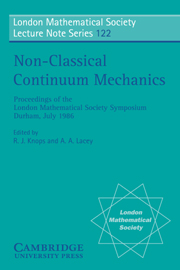 Non-Classical Continuum Mechanics
Non-Classical Continuum Mechanics Book contents
- Frontmatter
- FOREWORD
- Contents
- LIST OF PARTICIPANTS
- PART I PRINCIPAL LECTURES
- Pulse Reflection by a Random Medium
- Shape Memory Alloys-Phenomenology and Simulation
- Relativistic Extended Thermodynamics
- Spectra of Singularly Perturbed Operators
- Conservation Laws in Continuum Mechanics
- On Geometric and Modeling Perturbations in Partial Differential Equations
- The Appearance of Oscillations in Optimization Problems
- PART II SINGLE INVITED LECTURES
On Geometric and Modeling Perturbations in Partial Differential Equations
Published online by Cambridge University Press: 11 May 2010
- Frontmatter
- FOREWORD
- Contents
- LIST OF PARTICIPANTS
- PART I PRINCIPAL LECTURES
- Pulse Reflection by a Random Medium
- Shape Memory Alloys-Phenomenology and Simulation
- Relativistic Extended Thermodynamics
- Spectra of Singularly Perturbed Operators
- Conservation Laws in Continuum Mechanics
- On Geometric and Modeling Perturbations in Partial Differential Equations
- The Appearance of Oscillations in Optimization Problems
- PART II SINGLE INVITED LECTURES
Summary
INTRODUCTION
This paper discusses certain types of stability questions that have been largely ignored in the literature, i.e. continuous dependence on geometry and continuous dependence on modeling. Although we shall consider these questions primarily in the context of ill-posed problems we shall briefly indicate some difficulties that might arise under geometric and/or modeling perturbations in well posed problems.
In setting up and analyzing a mathematical model of any physical process it is inevitable that a number of different types of errors will be introduced e.g. errors in measuring data, errors in determining coefficients, etc. There will also be errors made in characterizing the geometry and in formulating the mathematical model. In most standard problems the errors made will induce little error in the solution itself, but for ill-posed problems in partial differential equations this is no longer true.
Throughout this paper we shall assume that a “solution” to the problem under consideration exists in some accepted sense, but in the case of ill-posed problems such a “solution” will invariably fail to depend continuously on the data and geometry. We must appropriately constrain the solution in order to recover the continuous dependence (see [8]); however, appropriate restrictions are often difficult to determine. In the first place any such constraint must be both mathematically and physically realizable. At the same time a given constraint must simultaneously stabilize against all possible errors that may be made in setting up the mathematical model of the physical problem. Since a constraint restriction has the effect of making an otherwise linear problem nonlinear, one must use care in treating the various errors separately and superposing the effects.
- Type
- Chapter
- Information
- Non-Classical Continuum MechanicsProceedings of the London Mathematical Society Symposium, Durham, July 1986, pp. 108 - 128Publisher: Cambridge University PressPrint publication year: 1987
- 13
- Cited by


